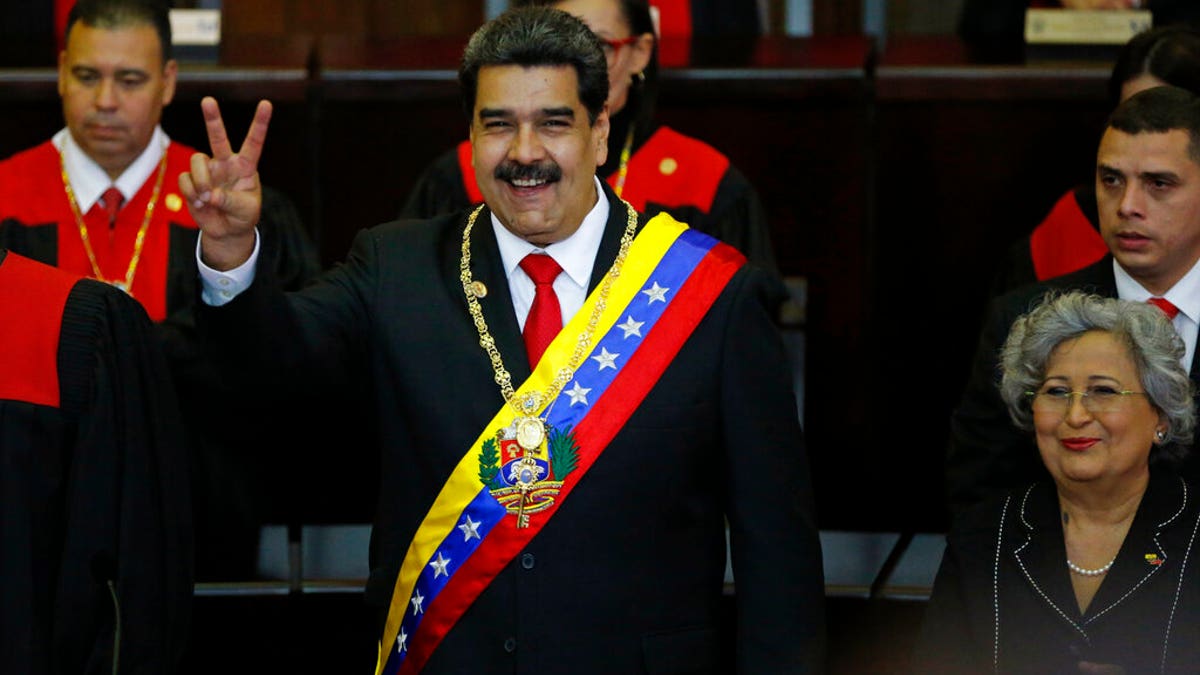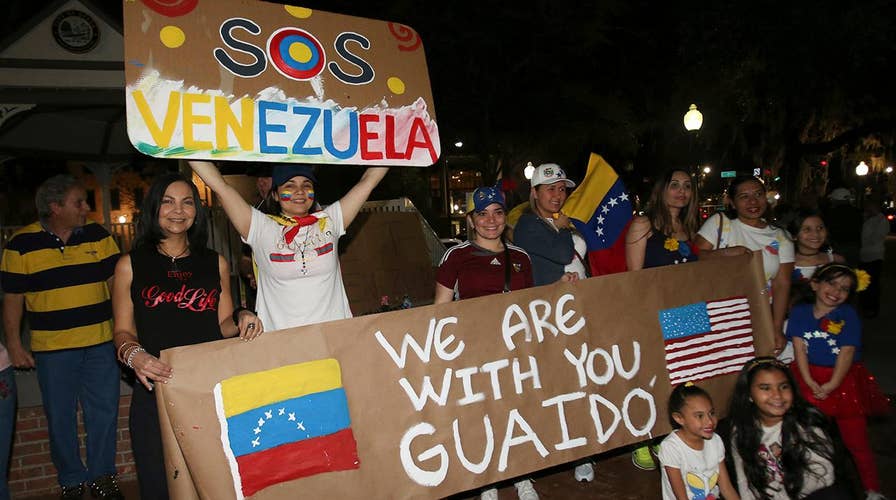Tension, unrest in Venezuela as opposition leader declares himself president
Former Venezuelan diplomat Isaias Medina reacts to the new push to topple Maduro.
The anti-government demonstrations that brought tens of thousands of Venezuelans into the streets this week, calling for regime leader Nicolas Maduro to step down and advocating support for National Assembly opposition leader Juan Guaido, haven't been particularly spontaneous.
“The big rallies and protests are called openly by opposition leaders. In this case, the congressmen are the ones leading them. They meet behind closed doors and plan a strategy and what the meaning of the demonstrations will be,” Noris Argotte, a journalist and activist in the capital of Caracas, told Fox News. “Then they make the official announcement.”
Opposition members started to meet quietly months ago in anticipation of next steps – biding their time until Jan. 10, when Maduro would be sworn in for a second presidential term, following what the U.S and much of the international community deemed a sham election.
“This is the biggest public mobilization in the history of Venezuela. Never before have we seen this incredible number of protesters asking Maduro to leave the country,” declared Jose Luis Pirela, member of the Venezuelan National Assembly. “We are looking to end this regime of terror in the next days.”
According to sources on the ground, immense precautions were taken by anti-Maduro political figures to avoid too much information being leaked to intelligence services, as the planning process got underway.
“Usually what they do is leave the location of the final destination of the march or the rally until the last minute, so government forces have less chance of trying to prevent them,” Argotte explained. “There is another big demonstration on Saturday. We still don’t have details on the exact location or the motivation behind it. They usually make the announcement one day before.”
In this case, the demonstrations were planned by the National Assembly and allied political parties. Sources told Fox News they delayed the act of Guaido taking an oath office immediately on Jan. 10th as “fake opposition factions” – still with loyalties to Maduro or their own interests – to meddle with the movement and claim it to be “unconstitutional.”
“There were powers that didn’t want Guaido as president, but he took his chances – with the people, with the USA behind him,” explained Cesar Oporeza, a filmmaker and political activist.
Guaido is said to have used Instagram to mobilize support over the past two weeks, posting a video last Friday "inviting” supporters to join his cause, and in due course capitalizing on a coalition of supporters made up of leaders from the church, military and educational institutions.
Social media played the most prominent role in drawing such large crowds, given that the government controls almost all of the traditional broadcast and print media.
“Getting the public involved really started on January 11th, when Guaido called for a massive concentration in all major cities. Opposition leaders, political parties, local leaders and student leaders then all got involved,” one political insider, well-versed in Venezuela intelligence operations, told Fox News. “And then at town hall meetings between the 11th of 20th of this month, more details were slowly shared with people across the country. Between the town hall meetings, social networks, press interviews and word of mouth the momentum was built.”
Nixon Moreno, one of the leaders of the Venezuelan Resistance, told Fox News the public is "kept informed" through social networks. But information is mostly spread through one person sending a text to another, and so on.
"Of course the protests are planned in secret, and very carefully because public meetings are prohibited," he said, emphasizing the public support, and support from the protest organizers - namely the National Assembly and the Civil Resistance is crucial in ensuring the safety of their new "president," Guaido.
While these demonstrations were largely peaceful, tensions soared late on Wednesday with some Venezuelans – their faces partially masked as tear gas from government forces intensified – throring rocks and Molotov cocktails in response.
The opposition rallies, which started Tuesday evening and grew significantly on Wednesday morning, marked the biggest opposition demonstrations in more than a year. An estimated 16 were killed, and dozens arrested. Past demonstrations against the Maduro leadership have also left scores dead, wounded and detained.
VENEZUELAN OPPOSITION LEADER LAMENTS "GENOCIDE" IN HIS COUNTRY, REVEALS HIS ESCAPE FROM DETAINMENT
COLOMBIA’S PEACE AGREEMENT BLOODIED BY DISTRUST, DRUGS - AND THE VENEZUELAN REGIME
In response, Maduro urged his own circle of supporters – who donned red – to also take to the streets. He also tired to expel U.S. diplomats - who have so far refused to leave - and remained unflinching that he will not be usurped from power.
Other, less notable protests have also taken place in recent years, designed to keep the momentum flowing - and test the ability of the government to crack down.
“When the opposition plans secret protests, it is often when they are trying to get to downtown Caracas where the Presidential Palace and other public power headquarters are located,” Argotte pointed out. “That is more a traditional Chavista zone, and for the opposition, it has become a symbol. But when protests start in more opposition zones, they are announced publicly.”
Since 2015, Venezuela – once slathered in oil money and the wealthiest country in Latin America – has been gripped by massive economic woes, dizzying hyperinflation, and mass medicine and food shortages that have prompted more than three million to flee the country in desperation.
And many on the inside say that while the organization of this round of protests was mostly the same as other major ones in years past, the sentiment has somewhat changed.
“People have a renewed sense of purpose. They see Guaido as not more of the same. They see support from the international community,” one source said. “And there is another thing – the poorest neighborhoods joined the protest. That is a new factor. And we see the government is heavily armed.”
Miguel Mandrade, an international relations analyst in the western Venezuelan city of San Cristobal, also highlighted that a demonstration decision was quietly made immediately after Maduro’s swearing in, to make Jan. 23 the movement marker.
“It’s a day with a high meaning for Venezuelan political history, the day in 1958 when the dictatorship of Marcos Perez Jimenez fell down,” he said. “We call it the 23E march, and it was a mixture of planned political protesting and totally spontaneous behavior from some military members and civilians.”
Mandrade stressed that in the two days leading up to Jan. 23, there were already some signs of a government clampdown – with around 27 soldiers captured by government soldiers in the Cotiza sector of Caracas under suspicion of being involved in a military rebellion.

Protests against the Nicolas Maduro regime in Caracas, Venezuela on Wednesday, Jan 23 2019 (Fox News)
But what happens next, and whether or not the protests will amount to any real change, is yet to be determined. According to experts, it is the response of Venezuela’s military to this move that matters most now and upon which the opposition’s hopes of a transition of power now rest.
“The current regime has proven adept at keeping itself in power in the face of a divided opposition. Furthermore, the government has systematically infiltrated the military, with local intelligence agents, as well as members of the Cuban intelligence services, embedded within its ranks to guard against the anti-regime activity,” noted Amanda Lapo, research analyst for defense and military analysis at the International Institute for Strategic Studies (IISS). “Venezuela's armed forces are also currently facing a complete collapse in terms of their operational capabilities, if a coup were to take place, this would have a detrimental impact on the armed forces’ ability to quickly take over key facilities, neutralize pro-government forces and establish a new government in a short period of time.”

Venezuela's President Nicolas Maduro makes a victory sign during his swearing-in ceremony at the Supreme Court in Caracas, Venezuela, Thursday, Jan. 10, 2019. Maduro was sworn in to a second term amid international calls for him to step down and a devastating economic crisis. (AP Photo/Ariana Cubillos)
But those who have taken to the streets are standing firm they will remain in full force, until the deed is done.
“We don’t want a bonus; we don’t want food boxes. We want Nicolas out. Things here are very bad, here people do not live, they cannot survive. Insecurity is very high, every day is worse,” Herminia Rodriguez, a 51-year-old lawyer from Los Rosales, Caracas told Fox News. “We will continue these protests until the government falls.”
Carmen Gonzalez, a 54-year-old architect from Caracas, concurred.
“People are tired of going hungry, people have lost their fear and the government’s lies are no longer believed,” she added. “Protests must continue until the government is changed.”




















